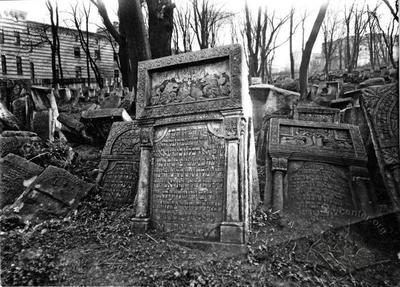Vul. Rappaporta – the old Jewish cemetery
The old Jewish cemetery was located within the limits circumscribed by contemporary Rappaporta, Kleparivska, Brovarna and Bazarna streets, in the place of the contemporary Krakivsky market. It was one of the oldest Jewish cemeteries in Europe mentioned for the first time in 1414. The cemetery has not been preserved.
Architecture
As for today, the former Jewish hospital of Maurycy Lazarus’ foundation (now the 3rd city clinical hospital on Rappaporta street 8), the outpatient clinic and a beggars’ hospital (now the clinical laboratory of the same hospital in Rappaporta 4 and 6) built for the needs of the Jewish community are located on a part of the old Jewish cemetery territory.
The entrance to the cemetery was from Shpytalna street through the yard of the Funeral Society, near the cart shed and the mortuary (do not exist anymore).
Before the Second World War the administration of the old Jewish cemetery made a supposition that the oldest gravestones were on the graves of baby Jakub (1348) and Mirjam, Seul’s daughter (1378). However, it is difficult to agree with this supposition because it was very hard to read inscriptions on the old gravestones.
Prominent persons were buried by the Jews in the very center of the cemetery; as Majer Bałaban wrote, it was a “Jewish pantheon.” The gravestones of Nachman and Mordechaj Izakowich (d. 1618), Izak Nachmanowicz (d. 1637), Izuje Falk (d. 1614), David Halevy (d. 1667), Roza “The Golden Rose” Nachmanowicz (Gildene Rojze; d. 1637), Adel Kikines of Drohobych (d. 1710), rabbi brothers Chajm and Jona Reises (d. 1728) were located there.
Rabbis Lewi ben Jakob Kikines (d. 1503), Chacham Zwi Ashkenazy (d. 1718), Chajm Rappaport (d. 1771), Jakob Ornstein (d. 1839), Abraham Kohn (d. 1848) were buried on the outskirts of the cemetery.
Not far from that place there was a row of 129 gravestones dated 1664, the fact indicating a considerable number of casualties of a massacre done by the Jesuit college students. In the spring of 1914 a committee was created in Lviv under the leadership of Samuel Horowitz that was engaged in restoring the gravestones of the Jewish cemetery, carrying out excavations in its territory and studying epitaphs. The committee charged historian Majer Bałaban with this work; the historian had also to publish a description of all the monuments of the cemetery. A considerable part of the cemetery was put in order at that time; many gravestones were unearthed and numbered, and about 1400 epitaphs were deciphered, including those of prominent persons. The oldest of the preserved monuments was dated 1530.
Related Places
Personalities
Abraham
Kohn – the first
chief reform rabbi of Lviv.
Władyław
Jagiełło
– a king of
Poland and a grand duke of Lithuania.
David
Halevy – the
author of the Turei
Zahav ritual codex.
Jean
du Desfilles –
the author of a 1766 plan of Lviv.
Izak
Nachmanowicz – a
rich Lviv usurer and merchant, the head of the town Jewish community
who financed construction of the Turei
Zahav synagogue
known also as The
Golden Rose or
Nachmanowycz’s synagogue.
Lewi
Freund – a Lviv
rabbi, one of the founders of the
Curatory for the Jewish Monuments Care.
Maurycy
Lazarus – the
Jewish hospital founder.
Majer
(Meir) Bałaban
– a Polish and
Jewish historian.
Mordechaj
Izaakowicz – a
rich citizen, Izak Nachmanowicz’s son, who founded the first Jewish
hospital in Lviv.
Nachman
Izaakowicz – a
rich citizen, Izak Nachmanowicz’s son.
Roza
Nachmanowicz (Gildene Rojze) –
the key figure of a legend about how the Jews got their synagogue
back; according to different sources, she might be Izak
Nachmanowicz’s wife or daughter.
Samuel
Horowitz – the
chief of a committee engaged in restoring the gravestones of the
Jewish cemetery, carrying out excavations in its territory and
studying epitaphs.
Sources
- Central State Historic Archive of Ukraine in Lviv (CDIAL) 129/3/268:1.
- CDIAL701/1/373.
- CDIAL701/3/1279.
- CDIAL742/1/980:8.
- M. Bałaban, Dzielnica żydowska. Jej dzieje i zabytki (Lwów: nakładem Towarzystwa Miłośników Przeszłości Lwowa, 1909), 78.
- M. Bałaban, Zabytki historyczne żydów w Polsce (Warszawa, 1929), 119.
- M. Bałaban, Zapomniały zabytek, Sztuka, 1911, S. 4-5.
Edited by Olha Zarechnyuk and Yulia Pavlyshyn
Media Archive Materials
Related Pictures





















